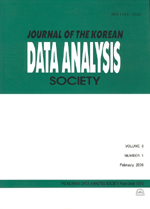교차상관함수를 이용한 외국인투자자 거래대금의 주가선행성에 대한 연구
A Study of Lead-Lag Relationship between Stock Trading Value of Foreign Investor and Stock Index using Cross-Correlation Analysis
- 한국자료분석학회
- Journal of The Korean Data Analysis Society (JKDAS)
- Vol.9 No.6
-
2007.122815 - 2823 (9 pages)
- 19

본 연구에서는 국내주식시장에서 외국인투자자의 거래대금이 주가지수의 예측변수로 활용될 수 있는가를 알아보기 위하여, 선행지표가 종속변수를 선행하는 시차를 탐색적으로 분석하는 교차상관분석을 이용하여 실증검정 하였다. 교차상관함수를 사용하여 외국인투자자의 매도대금과 종합주가지수 그리고 외국인 투자자의 매수대금과 종합주가지수사이의 인과관계에 대한 가설을 검정하였다. 분석결과에 의하면, 매도대금이 종합주가지수에 영향을 미치는 통계적으로 유의한 일 방향 인과관계가 성립되어 매도대금이 주가에 선행한다는 가설이 유의한 것으로 검정되었으나, 매수대금과 종합주가지수사이에는 통계적으로 유의한 양 방향의 인과관계가 성립되어, 두 변수 간에 서로 영향을 주고받는 것으로 나타났다. 즉 외국인투자자의 매도대금은 주가지수의 선행지표로 활용될 수 있으나 매수대금은 주가지수의 선행지표로 활용할 수 없다고 할 수 있다. 그러므로 본 연구에서 발견된 결과에 의하면, 국내 주식시장에서 주가지수의 예측변수로 외국인투자자의 매도대금과 매수대금이 함께 사용되고 있는데, 외국인투자자의 매수대금을 주가변동의 선행지표로 활용하여 투자전략을 수립하는 경우 주의를 하여야함을 시사하고 있다.
In this study, we test whether the stock trading value of foreign investigator in the Korean stock market can be utilized as a prediction variable for the stock index, using cross-correlation analysis method where the lag by which the leading indicator precedes a dependent variable is confirmed by plot. Cross-correlation function is used to verify the predicted lead-lag relationship between sales or purchase value of foreign investigator and the KOSPI. This study shows a statistically relevant one-way causal relationship between sales value and KOSPI, thereby confirming the lead-lag relationship of the two; sales value precedes the stock index. Stock purchase Value, however, appears to have a statistically relevant two-way causal relationship with the KOSPI and, thus the two variables effect each other. Therefore, stock sales value of foreign investigator can be used as a leading index of stock index while stock purchase value cannot. As the current Korean stock market uses both sales and purchase value of foreign investigators as prediction variables for the stock index, findings of our study raise caution against investigation strategies utilizing stock purchase value as a leading index in predicting stock value fluctuation.
1. 서론
2. 분석자료 및 연구방법
3. 실증분석
4. 결론
참고문헌
(0)
(0)